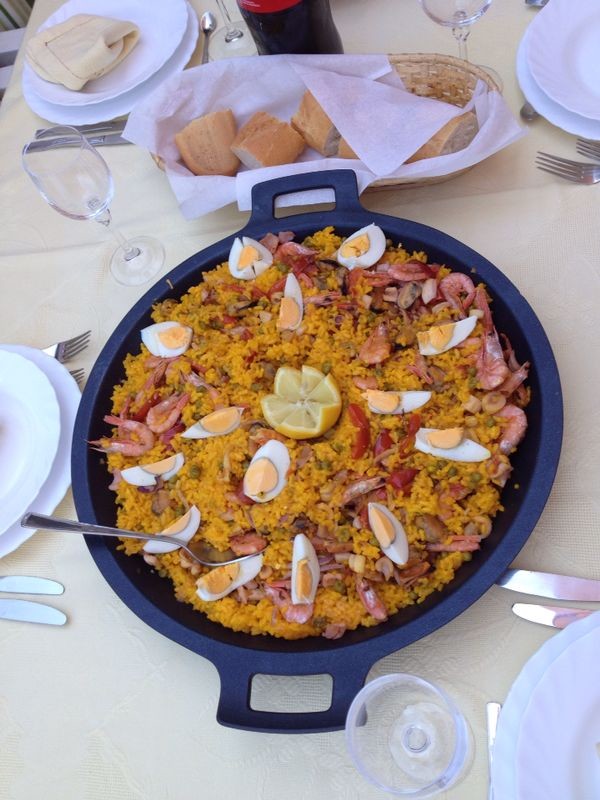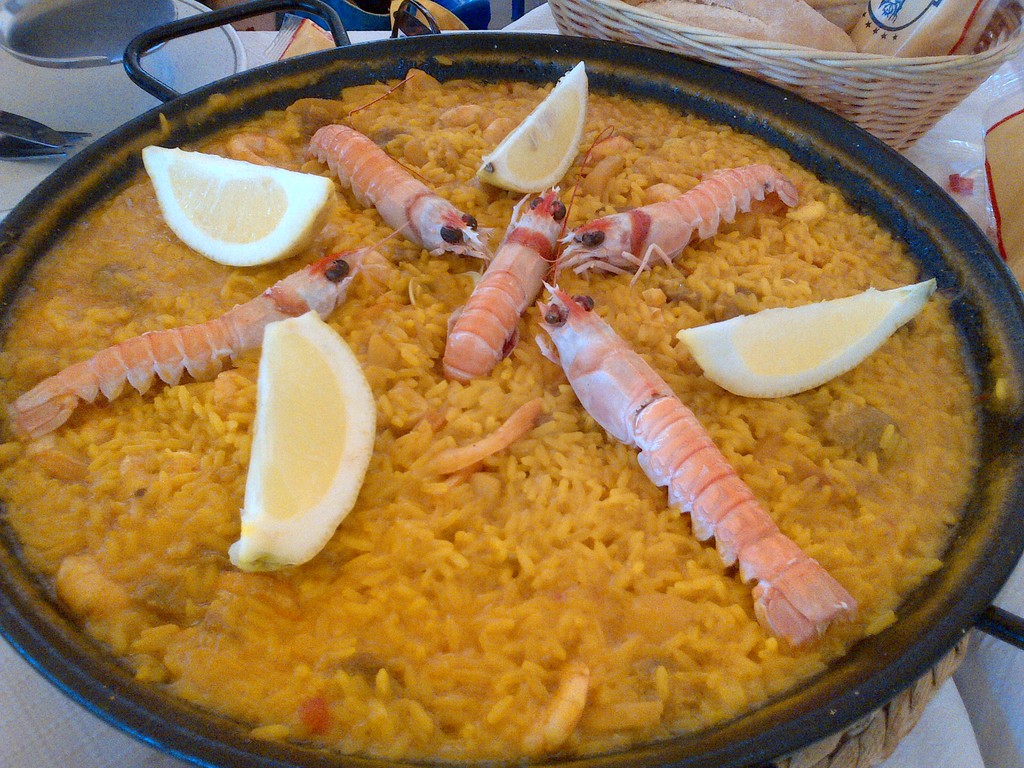Recipe: Paella
If there is a dish in Spain that can bring families together, that is certainly paella. Already the mode of serving this traditional Spanish food indicates that, as it is not served on individual plates, but in the paella, this very characteristic pan they cook it with, so that people can gather together around it and have a nice chat while eating.

[in the summer of 2014, with friends of my boyfriend's family, eating paella - look how happy everyone is]

If you are a beginner cook, don’t start with paella. However, it is actually not as difficult to prepare as it seems. I have already done it once, in the Christmas break when I returned to Hungary with my mom. For some reason, I still haven’t asked the mother of my boyfriend for the recipe, so I just looked up a random youtube video that I found the most professional and followed its instructions. I only realised later that it was actually uploaded on the Jamie Oliver channel, so at least we can make sure it is a good one. Of course, we didn’t have every single ingredients at home, so we could only prepare an easier version of it and this is what will appear in this post.
Ingredients:
- artichoke
- beans
- chicken
- about half a gram saffron
- 250 g short grain rice – preferably paella or Spanish rice
- olive oil – preferably extra virgin
- a generous amount of salt
- two or three clove of garlic
- smoked paprika
- two grated tomatoes
- 1, 5 litre chicken stock
Preparation:
We start with heating up our pan, which can be a real paella pan or any wide based pan, and at the same time we prepare the saffron. Saffron is a fundamental ingredient to this dish. If you couldn’t find Spanish saffron, which is already toasted, you will have to toast it yourself. This can be done by placing a small proportion on an aluminium paper, wrapping in up properly and then put it in the hot pan for about 10 seconds each side. This is essential, because this way, all its aromas will be released much easier.
The next step is to sprinkle a generous amount of salt on our pan, because we will be cooking many ingredients, and then add the olive oil as well. When we are sure that the pan is hot enough, we place the chicken in the pan and start to cook it on high heat until it gets a really deep brown colour, which will take about 15 minutes. The truth is that the recipe I was working with suggested to use chicken thighs and rabbit, but I used chicken thighs and breasts instead. It is up to you what kind of meat you want to have in your paella. As soon as the chicken got their nice brown colour, make a little bit of space for the vegetables and add them, and they similarly have to be cooked properly. At this point, we will also add the artichoke, but make sure to peel it properly and remove the inner heart, which is not an eatable part. We want all these vegetables to brown nicely.
Afterwards, lower the heat under the pan, chop two-three gloves of garlic and add them to the mixture with the smoked paprika and the grated tomatoes. Then we cook everything for about 2 minutes. When this is done, pour 1, 5 litre of chicken stock in the pan and give it a little stir. And this is the point where we will need the saffron, which we have to crush a little bit in our palms with our fingers. It goes into the boiling chicken stock.
The last step is to pour about 250 g of rice, stir it a little bit and make sure it spreads equally in the pan. We leave it untouched for a couple of minutes so that the rice evens properly and then we cook on high heat for about 10 minutes. It is important that we never stir the rice during this time, because otherwise it would release stodge, which is something we want to avoid. Afterwards, we leave the mixture to be cooked for another 5-10 minutes on a lower heat and with cover over the pan.
After this 5-10 minutes, our paella is ready. Even when we serve it, we shouldn’t stir it, so everyone gets some of the tastiest, crispy bottom part.
Enjoy your meal!
As you can see on the pictures, paella has tons of different preparation modes, you can top it up with eggs, prawns or any other sea food.

[eating paella in a restaurant in Islantilla]

[my first paella prepared in Hungary with my mom]
Photo gallery
Content available in other languages
- Italiano: Ricetta: Paella
- Español: Receta: paella
- Polski: Przepis: Paella
Want to have your own Erasmus blog?
If you are experiencing living abroad, you're an avid traveller or want to promote the city where you live... create your own blog and share your adventures!
I want to create my Erasmus blog! →







Comments (0 comments)